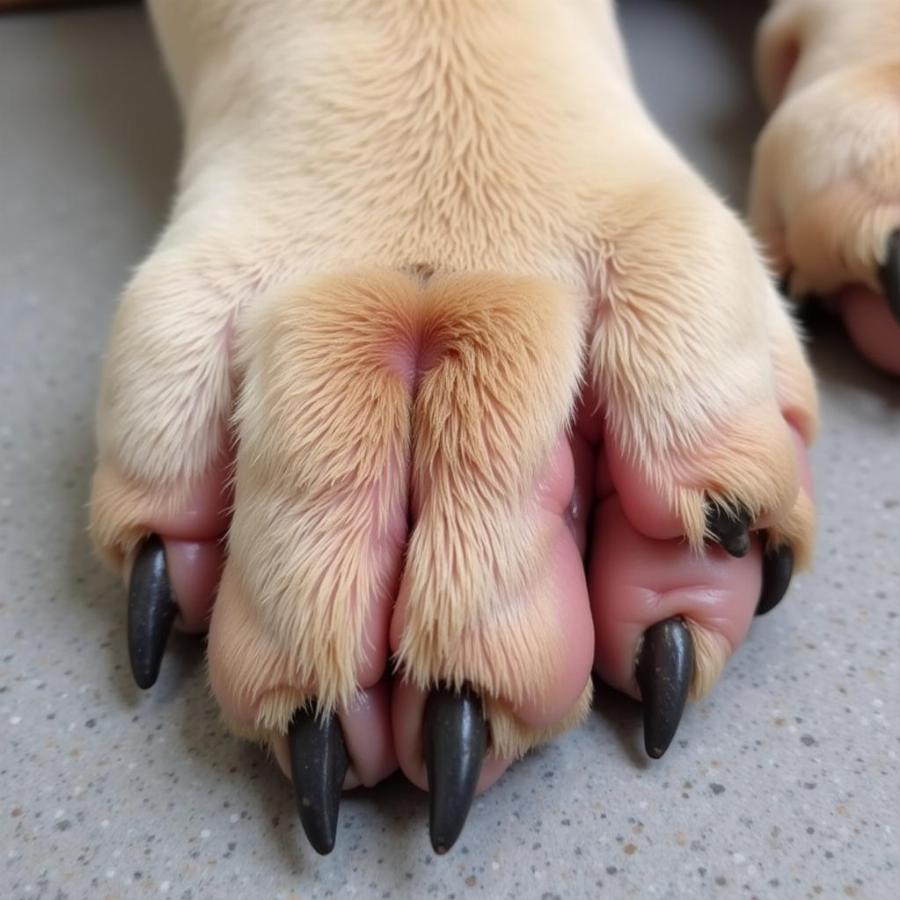A dog paw cut can be a worrying experience for any pet owner. Understanding dog paw cut healing time, proper care, and potential complications is crucial for ensuring your furry friend’s swift recovery. This comprehensive guide will provide you with all the necessary information to help your dog through this process.
Factors Influencing Dog Paw Cut Healing Time
Several factors influence how long it takes for a dog paw cut to heal. The severity of the cut plays a significant role. A minor scrape will naturally heal faster than a deep laceration. The location of the cut also matters. Paw pads endure constant pressure and friction, which can slow down healing. Furthermore, a dog’s overall health, age, and any underlying medical conditions can affect the healing process. Infection can significantly prolong healing time and lead to more serious complications.
Recognizing the Severity of a Paw Cut
A superficial cut might appear as a minor scrape or abrasion, often only affecting the outer layers of skin. These typically heal quickly with minimal intervention. Deeper cuts, however, may involve bleeding, exposed tissue, or even damage to underlying structures like tendons or bones. These require immediate veterinary attention.
Caring for a Dog Paw Cut at Home
For minor cuts, you can provide initial care at home. Start by gently cleaning the wound with warm water and a mild antiseptic solution. Avoid using hydrogen peroxide, as it can damage healthy tissue and impede healing. Pat the area dry and apply a pet-safe antiseptic ointment. Covering the wound with a clean bandage can prevent further contamination and licking.
Preventing Infection and Promoting Healing
Keeping the paw clean and dry is paramount to prevent infection. Change the bandage regularly and monitor the wound for any signs of infection, such as redness, swelling, pus, or a foul odor. Elizabethan collars (also known as e-collars or cones) are essential to prevent your dog from licking or chewing the wound, which can introduce bacteria and delay healing.
When to Seek Veterinary Care
While minor cuts can often be managed at home, deeper cuts or those showing signs of infection require immediate veterinary attention. If your dog is limping excessively, experiencing significant pain, or if the bleeding doesn’t stop, seek professional help. Your veterinarian can assess the wound, clean it thoroughly, prescribe antibiotics if necessary, and recommend the best course of action for healing.
How Your Vet Can Help
Your vet might recommend stitches or staples for deep lacerations to close the wound and promote healing. They can also provide pain relief medication and advise on appropriate bandaging techniques. In some cases, surgery may be required to repair damaged tendons or bones. Following your vet’s instructions meticulously is essential for a successful recovery.
Typical Dog Paw Cut Healing Time
Minor paw cuts typically heal within one to two weeks. Deeper cuts can take several weeks or even months to heal completely, depending on the extent of the injury and any complications. Consistent wound care, prevention of licking, and adherence to your veterinarian’s instructions are key to a smooth recovery.
FAQs About Dog Paw Cut Healing Time
How can I tell if my dog’s paw cut is infected? Signs of infection include redness, swelling, pus, a foul odor, increased pain, and excessive licking.
Can I use Neosporin on my dog’s paw cut? While some formulations of Neosporin are safe for dogs, it’s always best to consult your vet before applying any over-the-counter medication. You might also find our article about using neosporin on dogs helpful: can you put neosporin on a dog cut.
How can I keep my dog from licking its paw? An Elizabethan collar is the most effective way to prevent licking. You might also consider dog boots: petco dog boots.
What should I do if my dog’s paw is swollen? Swelling can be a sign of infection or a more serious injury. Consult your veterinarian promptly. Check out our article about swollen dog feet for more information: dogs foot swollen.
How can I speed up my dog’s paw cut healing time? Follow your vet’s instructions carefully, keep the wound clean and dry, prevent licking, and provide a healthy diet.
My dog has a clogged tear duct, is this related to their paw cut? A clogged tear duct is unlikely to be related to a paw cut. Find more information about clogged tear ducts in dogs here: clogged tear duct dog.
My dog seems to have a broken toe. How do I know for sure? If you suspect a broken toe, consult your vet immediately. More information on this topic can be found here: broken toe dog.
 Healed Dog Paw Cut
Healed Dog Paw Cut
Conclusion
Understanding dog paw cut healing time and providing appropriate care are crucial for your dog’s well-being. By being proactive and observant, you can help your furry friend recover quickly and comfortably.
Beaut Dogs is your trusted source for all things related to dog care, providing expert advice and helpful resources for dog owners. When you need assistance, contact us at [email protected] (Email address) for detailed and accurate answers. Visit Beaut Dogs today to learn more about the fascinating world of dogs and how to best care for them.